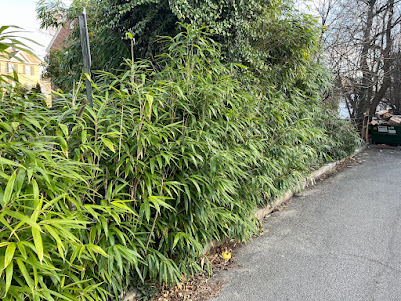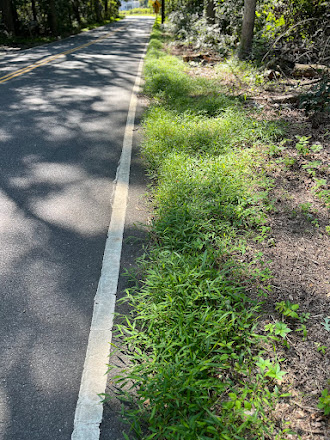Along the winding paths, there were old friends, like this thriving ombu. Lacking true wood, it is really an overgrown forb masquerading as a tree. I first encountered it in Argentina, where stories tell of it giving shelter to gauchos out on the pampas. Its latin name, Phytolacca dioica, shows it to be in the same genus as our pokeweed. If you saw it blooming, as I did once in a park in the Recoleta neighborhood of Buenos Aires, you might think you're looking at a pokeweed 50 feet high.
How often do we get to see a baobab tree, and a massive one at that?
Petrified wood triggered memories of visiting a petrified forest during a long drive through Argentine Patagonia.
And this swollen trunk brought the name "palo borracho" to mind, a name that translates to "drunken stick", in reference to the bottle-shape of the trunk. They are common along the streets of Buenos Aires. I think this one is Ceibe speciosa, the silk floss tree, closely related to the kapok tree.
The National Tropical Botanical Garden goes even farther in describing Fairchild's legacy:
"Avocado, mango, kale, quinoa, dates, hops, pistachios, nectarines, pomegranates, myriad citrus, Egyptian cotton, soybeans, and bamboo are just a few of the thousands, if not hundreds of thousands of plants Fairchild introduced to the United States."The desire to import plants that could prove useful for food, fiber, and other uses dates at least back to George Washington and Thomas Jefferson, but gained intensity during the golden age of travel--the late 19th century when Fairchild began his career. Plants were considered so important to the economy and security of the nation that the U.S. Botanic Garden--a particular passion of George Washington's--was placed next door to the Capitol building. That's it down in the lower left of this map.
To 21st or even 20th century eyes, the proximity of a botanical garden to the nation's center of legislative power feels odd in the extreme. Plants are more likely now to be viewed as quaint decoration to soften the edges of our hardened world. When I visited the U.S. Botanic Garden, probably in the 1990s, the conservatory looked a bit down in the mouth, largely serving as a refuge for the homeless. More respect for George Washington's dream has been shown since then.
Those must have been heady times, early in the 20th century, when Fairchild oversaw the import of more than 100,000 species of plants from around the world. Their utility and beauty promised to enrich our country by diversifying our farms, gardens and kitchens. Few, including Fairchild, wanted to think about the downside, as some of these imports escaped gardens and ran wild over the landscape, displacing native species. A botanical enrichment has contributed over time to an ecological degradation.
I looked into whether David Fairchild ever came to terms with the potential for introduced species to run amok, and plan to write about it in a separate post. He was aware that some nonnatives like kudzu and lebbek were spreading aggressively, but there is no verifiable evidence as yet that he sounded a warning.
It's heartening to see that the Fairchild Tropical Botanical Garden itself has evolved to take the threat of invasive species very seriously. According to multiple sources, it monitors closely its collection of exotic plants and takes action to prevent spread beyond the Garden's borders. I want very much to believe all this is true and will continue to be true, the better to enjoy the memory of my visit there, encountering so many old (plant) friends from my earlier travels around the world.






















































